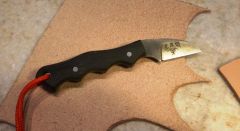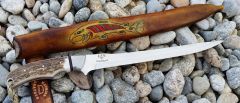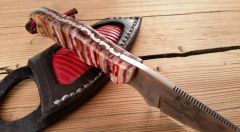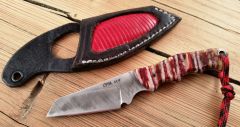-
Posts
328 -
Joined
-
Last visited
Content Type
Profiles
Forums
Events
Blogs
Gallery
Everything posted by rawcustom
-
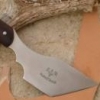
What Small Change(S) Helped Improve Your Leatherwork?
rawcustom replied to DavidL's topic in Leatherwork Conversation
CGleather, it's a quote from the movie... -
Looks like they work, and you can't beat the price. I've been making a couple based on a thread I read. One thing you might want to do is start with a stainless steel bolt or pin stock so you don't have to worry about rust and rust stains on your leather.
-

What Small Change(S) Helped Improve Your Leatherwork?
rawcustom replied to DavidL's topic in Leatherwork Conversation
Well it's 1 louder isn't it? -
Thanks everyone, you have given me a few more ideas to add to the inventory. Now all I need is to find the extra time to get them made. Thanks again.
-
Saw this thread and decided to time myself tonight. 20", 7 spi, 40 minutes. This was on 2/3 oz tooling veg tan, so I would be much slower on my knife sheaths, but luckily never have to sew 20" on a sheath.
-
That sunglasses case is a good idea. Any lining it it?
-
Thanks DoubleC. I'm actually struggling more with ideas for the smaller items than anything. Fighting the line between simple and cheap versus junk or "I can make that myself" items. For instance, I have hard time believing key chains would actually sell, and I think coin purses have become close to extinct, but these are just my opinions as I've never tried to sell them.
-
Took a gamble this summer and applied for a local artists and craftsman fair. This is kind of a departure from my knifemaking, as I plan to display mainly leather based goods. The thought being that I already have a fairly healthy customer base for my knives, but haven't yet done much on the leather side. So far I've made and held a couple minimalist style wallets, a nicer ladies wallet, and was planning to add a few more variations of these patterns and materials. Looking for any suggestions on items that tend to sell well at these type of events. I know offering a few lower priced products is a good idea, so I was planning on some magnetic money clips. Any suggestions are appreciated. Thanks
-

What Small Change(S) Helped Improve Your Leatherwork?
rawcustom replied to DavidL's topic in Leatherwork Conversation
Too many to list, but one of my best changes was using a sponge for applying dye. Cut off just a portion and rub the first swipes against cardboard before applying to your work. Also learning to apply some oil before dying helped a lot. -

Kidskin Wallet
rawcustom replied to rawcustom's topic in Purses, Wallets, Belts and Miscellaneous Pocket Items
Thanks! I can't believe how much I've learned on finishing leather alone since I joined this site. Takes a bit more work than what I had done in the past, but amazing all the different colors and contrasts you can work into a cowhide if you're willing to spend some time and elbow grease on it. -
Wanted to try out the kidskin I had on hand with a more minimalist style wallet. Thanks to the shared template: http://leatherworker.net/forum/index.php?showtopic=54776&page=8
-
Thanks for sharing this info. It is great as is and a very easy to manipulate into different versions.
-

Knife Sheath - 1St Attempt
rawcustom replied to Sven WillIBeFamous's topic in Gun Holsters, Rifle Slings and Knife Sheathes
You would need a lot of wear and use before that ring wears through, and probably more on top of that. It's not holding suspenders on a pancake eating champion, it's holding a knife and sheath that weigh only several ounces. -

Hello From Saginaw, Mi, Newbie In Leatherworking
rawcustom replied to rjmccants's topic in Member Gallery
Not from MI, but like to relate to that son of a Saginaw fisherman, if only to sell my father in law a Klondike claim. -
-
From the album: Knives and Sheaths
-

Detail/Trim knife with Mammoth Tooth handle
rawcustom posted a gallery image in Gallery- Our Leatherwork
From the album: Custom Leatherworking Knives and Tools
-

Detail/Trim knife with Mammoth Tooth handle
rawcustom posted a gallery image in Gallery- Our Leatherwork
From the album: Custom Leatherworking Knives and Tools
-

Hop Head Wallet
rawcustom replied to AndyL1's topic in Purses, Wallets, Belts and Miscellaneous Pocket Items
Very cool. I get tired of seeing oak leaves,acorns and such, this is a great idea for carving. -
I believe I read on another thread that guys were cutting it with water, and having to really mix it well. Your item is likely rather small, I've never fought with streaks from tan kote on something of that size. I apply liberally with a gauze pad and then wipe it off similar to a polyurethane finish on wood. Let it dry a few minutes and buff with a clean cotton rag. If you try this and aren't successful you could likely remove some of the excess with a rag and rubbing alcohol.
-
Ha, no Thor, that's not from a circular saw blade. Been a long time since I used mystery metals in my knives. I was confused for a moment, but realized you were keying in on the acid etch pattern I did. I added those sweeping acid etch lines to match the striation in the handle. The handle is stabilized mammoth tooth.
-

Wallet. Snake.
rawcustom replied to Samar's topic in Purses, Wallets, Belts and Miscellaneous Pocket Items
That is a BAMF wallet. -
Just finished up my second Scandinavian style sheath. Spring time is fishing time, so I've been building a few fillet knives. I like the wooden insert with these thin and pointed blades. I also made up a new leather trim knife using CPM-M4 steel and mammoth tooth for the handle. After finishing it up, I decided I should try to dress the sheath up a bit and did a lizard skin inlay. Thanks for looking.




